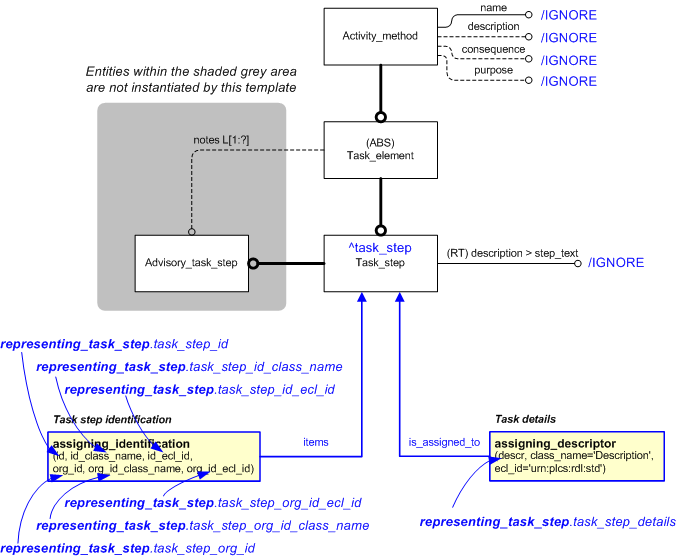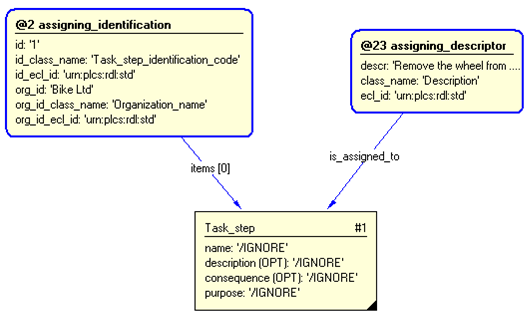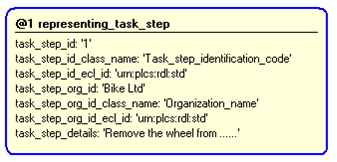| Template:— representing_task_step (rep_task_step) |
Date: 2010/01/28 09:39:51
Revision: 1.5
|
This section specifies the template representing_task_step.
NOTE
An explanation of a template and the associated instantiation path is
provided in the
Template overview
section.
This template describes how to represent a task step. A task step contains the details for a task version.
The EXPRESS-G diagram in
Figure
1
shows the templates and EXPRESS entities that are required
to represent the template
"representing_task_step".
The text highlighted in blue shows the template parameters.
Figure 1 — An EXPRESS-G representation of the Information model for representing_task_step
The graphic for the template to be used in other EXPRESS-G diagrams
is shown in Figure
2
below.
Figure 2 — The graphical representation of the representing_task_step template
The following input parameters are defined for this template:
The task step identifier, e.g. the task step number.
The name of the class being used to classify the task step identifier (i.e. the @task_step_id)
The following classes and their sub-classes can be used:
The identifier of the
External_class_library
storing the definition of the class referenced by the parameter @task_step_id_class_name.
The name or identifier of the
Organization that owns the @task_step_id.
The name of the class being used to classify the identification of the
Organization responsible for creating the @task_step_id.
The following classes and their sub-classes can be used:
The identifier of the
External_class_library storing the
definition of the class referenced by the parameter @task_step_org_id_class_name.
Detailed description of how the to perform the task step.
The following reference parameters are defined for this template:
Allow the
Task_step
entity instantiated in this path to be referenced when this template is used.
Note: The
Task_step
entity can be referenced in a template path by:
%^target = $representing_task_step.task_step%
where
target
is the parameter to which the
Task_step
is bound.
The instantiation path shown below specifies the entities that are to be
instantiated by the template.
A description of templates and the syntax for the instantiation path is
provided in the
Templates Help/Information section.
The following entities are instantiated with attributes as specified:
The instance diagram in Figure
3
shows an example of the EXPRESS entities and templates that are instantiated by the template:
/representing_task_step(task_step_id='1', task_step_id_class_name='Task_step_identification_code', task_step_id_ecl_id='urn:plcs:rdl:std', task_step_org_id='Bike Ltd', task_step_org_id_class_name='Organization_name', task_step_org_id_ecl_id='urn:plcs:rdl:std', task_step_details='Remove the wheel from ......')/
(an illustration of the consolidated representing_task_step template is shown in
Figure
4 below.)
Figure 3 — Entities instantiated by representing_task_step template
The instance diagram in
Figure
4
shows the graphic symbol for the template that is to be
used in other instance diagrams. The example template is:
/representing_task_step(task_step_id='1', task_step_id_class_name='Task_step_identification_code', task_step_id_ecl_id='urn:plcs:rdl:std', task_step_org_id='Bike Ltd', task_step_org_id_class_name='Organization_name', task_step_org_id_ecl_id='urn:plcs:rdl:std', task_step_details='Remove the wheel from ......')/
Figure 4 — Instantiation of representing_task_step template
Characterizations
No common characterizations of the template
representing_task_step
have been identified. However, the ISO 10303-239 EXPRESS model
may enable other assignments to the entities instantiated by the template.




